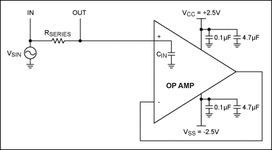Amr Wael
Member level 5
Hello ,
I wonder if there is a method to determine the input capacitance of an opamp whose value isn't mentioned in the data sheet. Could i simply use an LCR meter to measure the value of the capacitance ? Second question for the Oscillscopes I know that their input capacitance which is usually 16 pF is taken into consideration when designing the oscilloscope probes in order to avoid signal attenuation while increasing the frequency. Do I need to take the input capacitance of opAmp also in consideration (through adding capacitive dividers for example) if I am going to attenuate high voltage signals before it using resistive divider ? or is the resistive divider enough in case I am using voltage follower stages first between the voltage divider and between the Difference amplifier?
I wonder if there is a method to determine the input capacitance of an opamp whose value isn't mentioned in the data sheet. Could i simply use an LCR meter to measure the value of the capacitance ? Second question for the Oscillscopes I know that their input capacitance which is usually 16 pF is taken into consideration when designing the oscilloscope probes in order to avoid signal attenuation while increasing the frequency. Do I need to take the input capacitance of opAmp also in consideration (through adding capacitive dividers for example) if I am going to attenuate high voltage signals before it using resistive divider ? or is the resistive divider enough in case I am using voltage follower stages first between the voltage divider and between the Difference amplifier?
